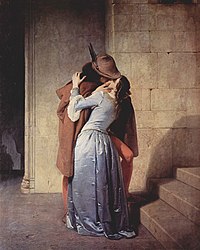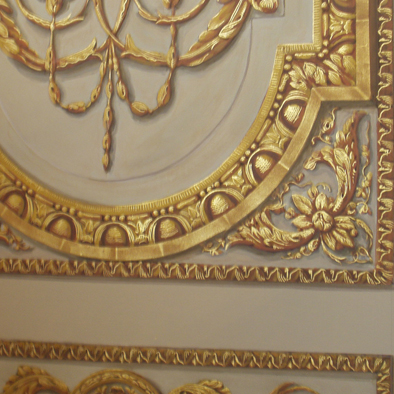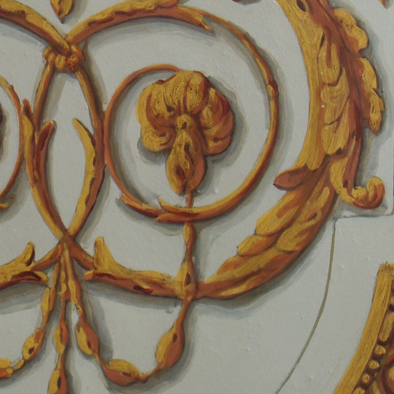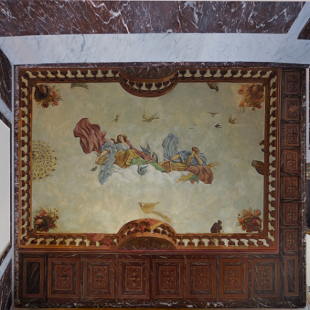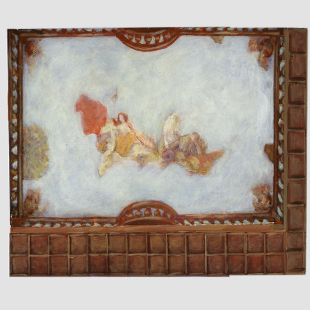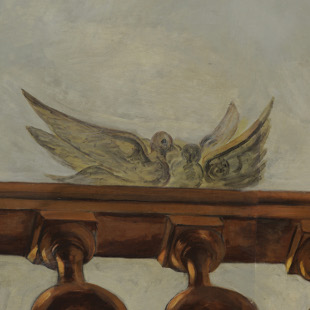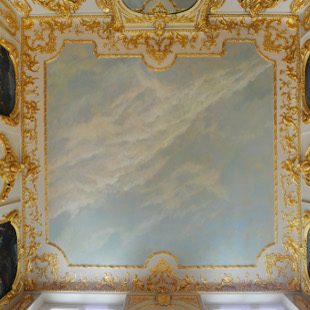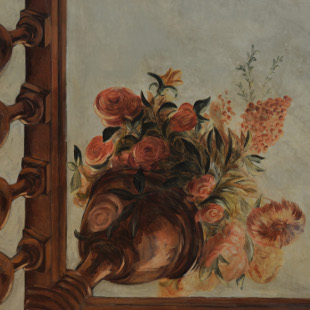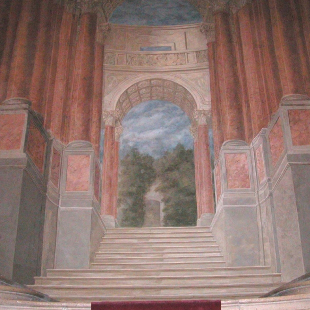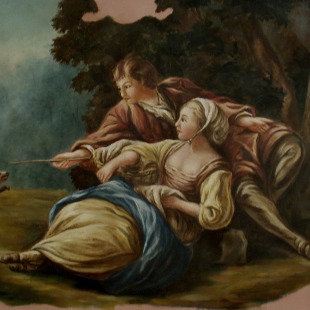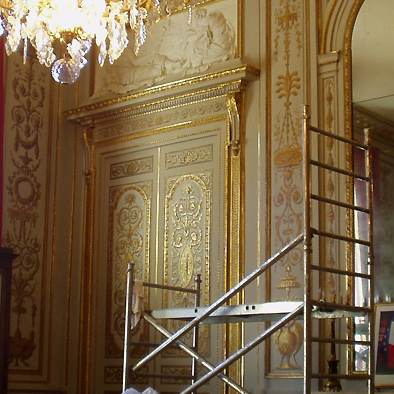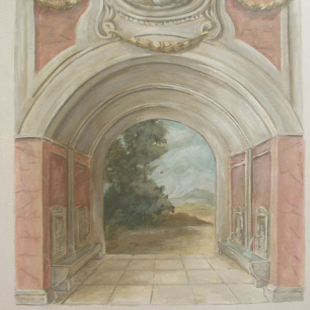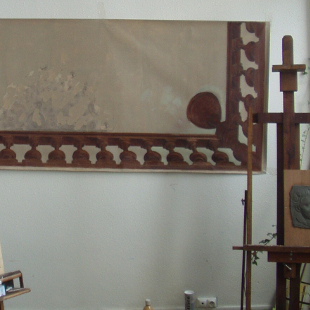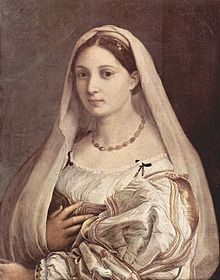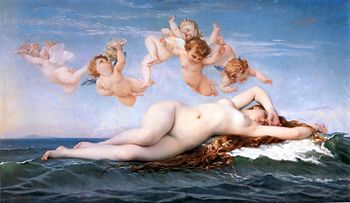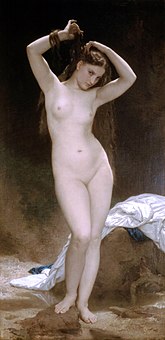|
|
|
|
|
Atelier 51
Christophe
GABRIEL
|
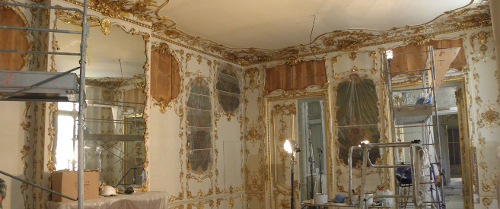 |
|
|
|
|
|
|
|
|
Création
et
restitution de peinture-murale, décors dans le respect des techniques et
l'esprit de l'époque.
|
|
Nous
travaillons généralement dans le domaine des monuments historiques mais
nous réalisons aussi des
projets pour des particuliers.
|
|
|
|
Nos
références : Château de Versailles, Château de EU, Hôtel de
Lassalle,Hôtel de Sully, Hôtel de Brienne, Théâtre des Champs Elysées,
Château de Champs sur
Marne... |
|
|
|
|
|
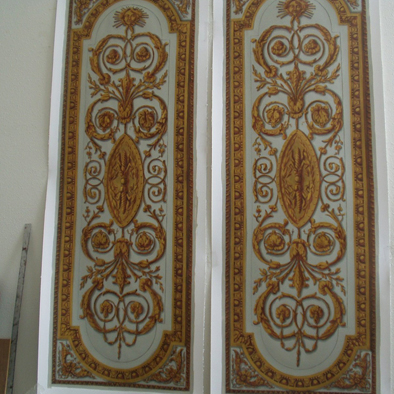 |
|
|
CONTACT:
ATELIER 51
17 rue du
Javelot
75013 Paris
01 45 85 77 77
06 19 30 59 92 |
|
|
|
contact@atelier-cg.com |
|
|
|
LIENS:
DECORATION MURALE
CONTEMPORAINE
CHRISTOPHE GABRIEL
ATELIER-CG.COM
|
|
|
|
|
|
|
|
|
|
|
|
|
| Mots clefs: Peinture-murale,
décoration, fresque, fresques, décors, décor, mural, art mural,
décoration, panoramique, panoramiques, décoration murale, peinture sur
mur |
|
Source http://fr.wikipedia.org
油画最早起源于欧洲,大约15世纪时由荷兰人发明的,用亚麻子油调和颜料,在经过处理的布或板上作画,因为油画颜料乾后不变色,多种颜色调和不会变得肮脏,画家可以画出丰富、逼真的色彩。油画颜料不透明,覆盖力强,所以绘画时可以由深到浅,逐层覆盖,使绘画产生立体感。油画适合创作大型、史诗般的巨作。成为西方绘画史中的主体绘画方式,现在存世的西方绘画作品主要是油画作品。绝大部分壁画作品也是用油画颜料和创作方式制作的。19世纪后期,由于科技发展,许多新材料应用于油画领域,如丙烯颜料,油漆等。
油画的发展流派
v
學院藝術(英文:academic art)是一種在歐洲藝術學院和大學的影響下所產生的繪畫和雕塑的流派。
學院藝術專指那些在新古典主義和浪漫主義運動中,受法兰西艺术院訂立的標準所影響的畫家和藝術品,以及跟隨着這兩種運動並試圖融合兩者作為風格的藝術,最具代表性的如威廉·阿道夫·布格罗、湯瑪斯·庫圖爾、漢斯·馬卡特(Hans Makart)。他們通常也常被稱為“學院派”(academism)、“華麗藝術”(art pompier)、“折衷主義”(eclecticism),有時也被人與歷史主義(Historicism)與融合主義(Syncretism)相提並論。
一般來說,被學院所影響的藝術都稱為「學院藝術」,例如劳伦斯·阿尔玛-塔德玛的作品。在這個背景下,學院藝術不斷吸收新的風格,所以一些曾被視為對抗學院藝術的藝術風格,後來也被人稱為學院藝術。
Traditional Murals
Many people like to express their individuality by commissioning an
artist to paint a mural in their home, this is not an activity
exclusively for owners of large houses. A mural artist is only limited
by the fee and therefore the time spent on the painting; dictating the
level of detail; a simple mural can be added to the smallest of walls.
Private commissions can be for dining rooms, bathrooms, living rooms
or, as is often the case- children's bedrooms. A child's room can be
transformed into the 'fantasy world' of a forest
or racing track, encouraging
imaginative play and an awareness of art.
The current trend for feature walls has increased commissions for
muralists in the UK. A large hand-painted mural can be designed on a
specific theme, incorporate personal images and elements and may be
altered during the course of painting it. The personal interaction
between client and muralist is often a unique experience for an
individual not usually involved in the arts.
Public commissions of murals in schools, hospitals and retirement
homes can achieve a pleasing and welcoming atmosphere in these caring
institutions.[4]
In the 1980s, illusionary wall painting experienced a renaissance in
private homes. The reason for this revival in interior design could, in
some cases be attributed to the reduction in living space for the
individual. Faux architectural features as well as natural scenery and
views can have the effect of 'opening out' the walls. Densely built up
areas of housing may also contribute to people's feelings of being cut
off from nature in its free form. A mural commission of this sort may
be an attempt by some people to re-establish a balance with nature.
Tile mural
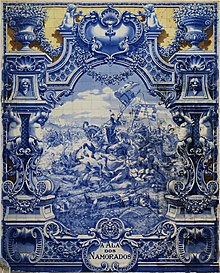
Panel of glazed tiles by Jorge Colaço (1922) depicting an episode from
the battle of
Aljubarrota (1385) between
the Portuguese and
Castilian armies. A piece of public art
in
Lisbon,
Portugal.
Tile murals tile paintings, which cover complete walls and give a
wall painting-like impression. Tile murals are typically found in
countries around the Mediterranean Sea such as Morocco,
Tunisia
and Arabic countries, in Portugal
and Spain
mostly in an often monochrom-colored form, the Azulejo.
The Azulejo (Portuguese pronunciation: [ɐzuˈleʒu],
Spanish pronunciation: [aθuˈlexo]) refers to a
typical form of Portuguese or Spanish
painted, tin-glazed, ceramic
tilework.
They have become a typical aspect of Portuguese culture, manifesting
without interruption during five centuries the consecutive trends in
art.
Azulejos can be found inside and outside churches, palaces,
ordinary houses and even train
stations or subway stations. They
were not only used as an ornamental art form, but also had
a specific functional capacity like temperature control at homes. Many
azulejos chronicle major historical and cultural aspects of Portuguese history.
Today several companies create custom tile murals using dye
sublimation as well as other processes for commercial and residential
spaces. Images in Tile, USA is an example of a large scale mural
manufacturer.
.
壁畫
维基百科,自由的百科全书跳转到: 导航,
搜索

壁畫是一種裝飾牆壁和天花板的繪畫,可說是最原始的繪畫型式。最早的壁畫是在法國一個山洞中發現的,因此有時壁畫也稱洞穴畫。壁畫的歷史發展到最後,
變成建築裝飾,和室內裝飾的一種,彩磚也是壁畫的一種。都市裡面青少年反動性的塗鴉,
也算是壁畫之一,戶外廣告如果是用繪畫的型式製作的,也是壁畫。
壁畫創作時,要考慮到牆壁的結構,壁畫的創作可改變整體空間的比例和感受。
壁畫是古蹟修
復人員的挑戰與難題,因為牆壁不像其他畫作能裱框,收藏,覆上玻璃保
護,所以只要是年代久遠的壁畫,受損的情形都很嚴重。因此很珍貴,也很有價值。
學院藝術歷史
乔治·瓦萨里在1562年於佛罗伦萨創建了第一間藝術學院,被人稱為藝術繪畫學院(Accademia dell' Arte del Disegno),學生在學院裡學習繪畫的技巧,包括解剖學和幾何學。另外一間學院,聖路卡學院(Accademia di San Luca, 以畫家的保護聖徒聖路加為名),則在十年後於羅馬創立。比較起佛羅倫斯的藝術繪畫學院,聖路卡學院主要作為教育用途,並且更專注於藝術理論上。
聖路卡學院成為了後來在1648年於法國成立的法國皇家繪畫暨雕刻學院(Académie royale de peinture et de sculpture)的模型,並在後來成為法兰西艺术院。法國學院可能是採納了“arti del disegno”翻譯為“beaux arts(文雅藝術)”,後來又被英國人翻譯為“fine arts(美术)”。皇家繪畫暨雕刻學院成立的目的是為了區分那些“從事自由藝術創作的紳士”與一般以體力勞動的工匠,這種強調由知識份子組成的傾向,對於學院藝術的題材和風格影響深遠。
路易十四為加強控制法國藝術界,於1661年重組法國皇家繪畫暨雕刻學院。這時學院在藝術的態度上產生了爭議,這場名為“風格之戰”的爭論重心在於,應以鲁本斯還是尼古拉·普桑作為模範。支持莫桑的被稱為莫桑派,主張“線(disegno)”應該支配藝術的創作,因為那訴諸於智慧。支持魯本斯的則被稱為魯本斯派,主張“顏色(colore)”應該支配藝術的創作,因為那訴諸於情感。
這場爭論在19世紀再度展開,發生在以安格尔作品為代表的新古典主義、和以欧仁·德拉克罗瓦作品為代表的浪漫主義之間。爭論同樣在於究竟應以觀察大自然作為樣本,還是觀察由畫家所控制的記憶作為樣板。
以法國作為樣本創立的學院遍及了全歐洲,也模仿了法國的教學法和風格。這在英國則成為了皇家藝術學院。
學院風格的發展
自從藝術界裡莫桑派—魯本斯派間的爭論以來,在19世紀這種爭論的形式再度展開時,藝術的重點和目標成為了融合新古典主義的“線”以及浪漫主義的“顏色”。一個接一個的畫家被評論者認為他們已經達成了這種融合,包括泰奥多尔·夏斯里奥、阿里·謝佛爾(Ary Scheffer)、弗朗西斯科·海耶茲(Francesco Hayez)、亞歷山大·加百利·德康(Alexandre-Gabriel Decamps)和湯瑪斯·庫圖爾。後來的學院派畫家威廉·阿道夫·布格罗對此評論道,成為一個好畫家的方法便是“將線和顏色當作是一回事”。
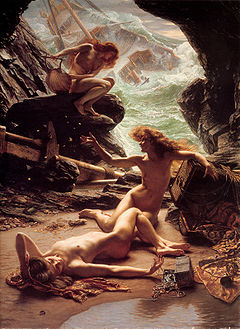
Cave of the Storm Nymphs(暴風雨中水仙女的巢穴),
愛德華·潘特(Edward Poynter)
湯瑪斯·庫圖爾在他所著的書中宣揚了這種概念—主張那些宣稱一幅畫有比較好的線或比較好的顏色的說法都是胡說八道,因為顏色要靠著線來傳達它才能表現出色,而反之亦然;顏色是表達“形狀”的一種確實方法。
在這個時期的另一種發展包含了採納歷史的風格,以顯現出畫中所描繪的時代,這稱為歷史主義(historicism)。這種方法以亨德利克·利思(Henrik Leys)的作品為代表,他也影響了詹姆斯·迪索(James Tissot)。歷史主義也表示了學院藝術中,應該結合並融合過去藝術與不同傳統的看法和作法。
藝術世界也越來越注重藝術上的象徵法。
主張“線”和“顏色”的兩派都聲稱透過象徵的手段,畫家可以經由這些象徵元素作為媒介來控制作品所能產生的心理影響,作品的主題、情感、和觀念都能這樣表
現出來。由於畫家試圖在作法上融合這些理論,也強調了藝術作品在作為比喻和象徵上之媒介的角色。他們主張繪畫或雕刻應該以柏拉圖的形式或觀念來陳述,使觀看者能在尋常的描繪上看到更深一層的抽象涵義,一些永恆的真理。因此如同约翰·济慈的名言“美就是真,真就是美”,繪畫應該是一種完全而完整的“觀念”。布格罗曾說過他不會畫出“某場戰爭”,而只會畫出“戰爭”(的本身)。許多學院藝術畫家的繪畫都只簡單的取名為黎明、黃昏、視覺、品嘗等等,而這些觀念都只由畫中裸體的人物來具體化,以這種方法來說明觀念的本質。
學院藝術也相當偏向理想主義,與現實主義成為強烈反面對比。畫中的角色都被描繪的簡單而更抽象化—理想化—以表現出他們所要表達的觀念。這包含了自然狀態下的一般形式,以及將其轉化以和藝術作品中的主題搭配。
由於歷史和神化被視為是陳述觀念的辩证法和表達法,能提供象徵上的豐富題材,運用這些主題作為題材被視為繪畫中最重要的一部分。在17世紀所提出的藝術等級(hierarchy of genres)便劃分了藝術題材的價值,在這套劃分法中,歷史繪畫—古典、宗教、神話、文學、和帶有寓意的主題—被列為最有價值的題材,接下來的排名則依序是風俗畫、肖像畫、靜物畫、風景畫。歷史繪畫也常被稱為“偉大的題材”。漢斯·馬卡特(Hans Makart)的繪畫通常都是超越了生命的歷史戲劇題材,他以此與歷史主義作搭配,支配了19世紀維也納的文化風格。德拉罗什也是典型的歷史畫家。
所有這些傾向都受到了哲學家黑格尔的影響,他認為歷史的辯證法最終只會出現一種答案,以綜合體的形式來解決。
到了19世紀晚期,學院藝術風行整個歐洲社會。學院藝術的展覽相當頻繁,最受歡迎的展覽是在1903年開始的巴黎沙龍(Paris Salon),這次沙龙展
覽相當轟動,吸引了大量本地和國外的參觀者。在某個星期日一天中便吸引了50,000人參觀,2個月裡總計約500,000人參觀了展覽。數千幅畫作被展
出,從人的視線高度直到天花板間擺滿畫作。在沙龍中成功的展覽是對畫家們成就的認可,使他們的畫作能能被越來越多的個人收藏家買下。威廉·阿道夫·布格罗、亞歷山大·卡巴內爾(Alexandre Cabanel)、让-莱昂·热罗姆則是當時藝術界的主要人物。
在學院藝術全盛的時期,洛可可時代不受歡迎的畫作也開始重新流行,而洛可可藝術中常用的題材如爱罗斯和丘比特等也重受歡迎。儘管拉斐爾事實上較為偏向米开朗基罗,學院藝術也相當崇拜拉斐爾那些帶有理想化的作品,
學院藝術不只影響了歐洲和美國,也影響了一些非西方的國家。尤其是在拉丁美洲的國家,由於他們的革命是以法國大革命作樣本,也試著在文化上模仿法國。例如Angel Zarraga便是墨西哥的學院藝術畫家。
學院藝術(英文:academic art)是一種在歐洲藝術學院和大學的影響下所產生的繪畫和雕塑的流派。
學院藝術專指那些在新古典主義和浪漫主義運動中,受法兰西艺术院訂立的標準所影響的畫家和藝術品,以及跟隨着這兩種運動並試圖融合兩者作為風格的藝術,最具代表性的如威廉·阿道夫·布格罗、湯瑪斯·庫圖爾、漢斯·馬卡特(Hans Makart)。他們通常也常被稱為“學院派”(academism)、“華麗藝術”(art pompier)、“折衷主義”(eclecticism),有時也被人與歷史主義(Historicism)與融合主義(Syncretism)相提並論。
一般來說,被學院所影響的藝術都稱為「學院藝術」,例如劳伦斯·阿尔玛-塔德玛的作品。在這個背景下,學院藝術不斷吸收新的風格,所以一些曾被視為對抗學院藝術的藝術風格,後來也被人稱為學院藝術。
主要藝術家
